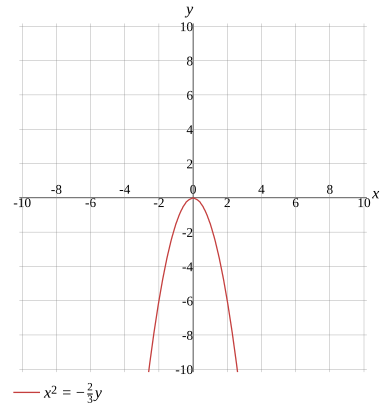Question
Function
Find the x-intercept/zero
Find the y-intercept
x=0
Evaluate
−8y=3x2×4
To find the x-intercept,set y=0
−8×0=3x2×4
Any expression multiplied by 0 equals 0
0=3x2×4
Multiply the terms
0=12x2
Swap the sides of the equation
12x2=0
Rewrite the expression
x2=0
Solution
x=0
Show Solution

Solve the equation
Solve for x
Solve for y
x=3−6yx=−3−6y
Evaluate
−8y=3x2×4
Multiply the terms
−8y=12x2
Swap the sides of the equation
12x2=−8y
Divide both sides
1212x2=12−8y
Divide the numbers
x2=12−8y
Divide the numbers
More Steps


Evaluate
12−8y
Cancel out the common factor 4
3−2y
Use b−a=−ba=−ba to rewrite the fraction
−32y
x2=−32y
Take the root of both sides of the equation and remember to use both positive and negative roots
x=±−32y
Simplify the expression
More Steps


Evaluate
−32y
To take a root of a fraction,take the root of the numerator and denominator separately
3−2y
Multiply by the Conjugate
3×3−2y×3
Calculate
3−2y×3
Calculate
More Steps


Evaluate
−2y×3
The product of roots with the same index is equal to the root of the product
−2y×3
Calculate the product
−6y
3−6y
x=±3−6y
Solution
x=3−6yx=−3−6y
Show Solution

Testing for symmetry
Testing for symmetry about the origin
Testing for symmetry about the x-axis
Testing for symmetry about the y-axis
Not symmetry with respect to the origin
Evaluate
−8y=3x24
Simplify the expression
−8y=12x2
To test if the graph of −8y=12x2 is symmetry with respect to the origin,substitute -x for x and -y for y
−8(−y)=12(−x)2
Evaluate
8y=12(−x)2
Evaluate
8y=12x2
Solution
Not symmetry with respect to the origin
Show Solution

Identify the conic
Find the standard equation of the parabola
Find the vertex of the parabola
Find the focus of the parabola
Load more

x2=−32y
Evaluate
−8y=3x2×4
Calculate
−8y=12x2
Swap the sides of the equation
12x2=−8y
Multiply both sides of the equation by 121
12x2×121=−8y×121
Multiply the terms
x2=−8y×121
Solution
More Steps


Evaluate
−8×121
Reduce the numbers
−2×31
Multiply the numbers
−32
x2=−32y
Show Solution

Rewrite the equation
r=0r=−32sin(θ)sec2(θ)
Evaluate
−8y=3x2×4
Evaluate
−8y=12x2
Move the expression to the left side
−8y−12x2=0
To convert the equation to polar coordinates,substitute x for rcos(θ) and y for rsin(θ)
−8sin(θ)×r−12(cos(θ)×r)2=0
Factor the expression
−12cos2(θ)×r2−8sin(θ)×r=0
Factor the expression
r(−12cos2(θ)×r−8sin(θ))=0
When the product of factors equals 0,at least one factor is 0
r=0−12cos2(θ)×r−8sin(θ)=0
Solution
More Steps


Factor the expression
−12cos2(θ)×r−8sin(θ)=0
Subtract the terms
−12cos2(θ)×r−8sin(θ)−(−8sin(θ))=0−(−8sin(θ))
Evaluate
−12cos2(θ)×r=8sin(θ)
Divide the terms
r=−3cos2(θ)2sin(θ)
Simplify the expression
r=−32sin(θ)sec2(θ)
r=0r=−32sin(θ)sec2(θ)
Show Solution

Find the first derivative
Find the derivative with respect to x
Find the derivative with respect to y
dxdy=−3x
Calculate
−8y=3x24
Simplify the expression
−8y=12x2
Take the derivative of both sides
dxd(−8y)=dxd(12x2)
Calculate the derivative
More Steps


Evaluate
dxd(−8y)
Use differentiation rules
dyd(−8y)×dxdy
Evaluate the derivative
More Steps


Evaluate
dyd(−8y)
Use differentiation rule dxd(cf(x))=c×dxd(f(x))
−8×dyd(y)
Use dxdxn=nxn−1 to find derivative
−8×1
Any expression multiplied by 1 remains the same
−8
−8dxdy
−8dxdy=dxd(12x2)
Calculate the derivative
More Steps


Evaluate
dxd(12x2)
Use differentiation rule dxd(cf(x))=c×dxd(f(x))
12×dxd(x2)
Use dxdxn=nxn−1 to find derivative
12×2x
Multiply the terms
24x
−8dxdy=24x
Change the signs on both sides of the equation
8dxdy=−24x
Divide both sides
88dxdy=8−24x
Divide the numbers
dxdy=8−24x
Solution
More Steps


Evaluate
8−24x
Reduce the numbers
1−3x
Calculate
−3x
dxdy=−3x
Show Solution

Find the second derivative
Find the second derivative with respect to x
Find the second derivative with respect to y
dx2d2y=−3
Calculate
−8y=3x24
Simplify the expression
−8y=12x2
Take the derivative of both sides
dxd(−8y)=dxd(12x2)
Calculate the derivative
More Steps


Evaluate
dxd(−8y)
Use differentiation rules
dyd(−8y)×dxdy
Evaluate the derivative
More Steps


Evaluate
dyd(−8y)
Use differentiation rule dxd(cf(x))=c×dxd(f(x))
−8×dyd(y)
Use dxdxn=nxn−1 to find derivative
−8×1
Any expression multiplied by 1 remains the same
−8
−8dxdy
−8dxdy=dxd(12x2)
Calculate the derivative
More Steps


Evaluate
dxd(12x2)
Use differentiation rule dxd(cf(x))=c×dxd(f(x))
12×dxd(x2)
Use dxdxn=nxn−1 to find derivative
12×2x
Multiply the terms
24x
−8dxdy=24x
Change the signs on both sides of the equation
8dxdy=−24x
Divide both sides
88dxdy=8−24x
Divide the numbers
dxdy=8−24x
Divide the numbers
More Steps


Evaluate
8−24x
Reduce the numbers
1−3x
Calculate
−3x
dxdy=−3x
Take the derivative of both sides
dxd(dxdy)=dxd(−3x)
Calculate the derivative
dx2d2y=dxd(−3x)
Simplify
dx2d2y=−3×dxd(x)
Rewrite the expression
dx2d2y=−3×1
Solution
dx2d2y=−3
Show Solution

Graph
